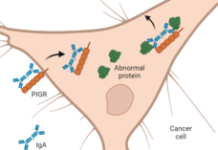The article is provided by Scientific Communications Officer of NIPD Genetics, Ms Marina Charitou (MSc)
Prostate Cancer Awareness
Prostate cancer is the second most common cancer in men worldwide. It develops due to the uncontrollable growth of cells in the prostate, a walnut-sized organ found underneath the bladder and around the urethra in men. The prostate grows with age, and its main function is to help in semen production.
Every year, over 1.2 million men are diagnosed with prostate cancer. Generally, 1 in 9 men will develop prostate cancer in their lifetime – and for unknown reasons, 1 in 4 African American men. Typically described as ‘an older man’s cancer’, prostate cancer is rarely diagnosed in men under 50 years of age, with 66 years old being the average age of diagnosis. Prostate cancer risk increases exponentially with age – while men under 50 have 1 in 350 chance of developing prostate cancer, men between 50 and 59 years old have 1 in 52 chance and men over 60 years old have 1 in 19 chance. Besides racial background and age, smoking, obesity, geographical location – Asians have a significantly lower prostate cancer incidence than that of Europeans and African Americans ¬– and family history are important risk factors for prostate cancer. The risk is higher for men with a first degree relative diagnosed with cancer, specifically at a young age. The risk increases when several relatives have been affected by cancer; when the mother or sister has been diagnosed with breast cancer; or when the father or brother has been diagnosed with prostate cancer. When cancer clusters in families like this it is usually caused by a germline mutation – an inherited genetic change that raises a person’s chance of developing cancer. Up to 10% of prostate cancers can be due to germline mutations and are referred to as ‘hereditary cancers’. Hereditary cancer screening is available to test for these mutations in individuals with a family history of cancer to let them know early of their risk, allow them to take informed decisions about their treatment and have better medical care.
If detected early, when the cancer is still localized, prostate cancer has excellent prognosis with the 5-year survival rate being nearly 100%. When the cancer has metastasized – spread to other areas and organs beyond its original location – survival rate falls by a third. Detecting prostate cancer early is difficult because there are no symptoms during the early stages. As the tumor on the prostate starts small – and doesn’t affect or press on any other organs – there rarely is any pain or discomfort. Symptoms may be noticeable as the tumor gets bigger and possibly starts pressing on the urethra. These may include an increased need to urinate, a feeling that the bladder hasn’t emptied, a weak flow while urinating, difficulty when starting to urinate and painful urination. Back pain, erectile dysfunction, blood in the urine or semen, and unexplained weight loss could appear at more advanced stages of the disease. These symptoms may be prompted by other causes apart from prostate cancer – prostatitis or prostate enlargement – so it’s important for men to consult their healthcare provider if they experience anything unusual.
The most common tests to detect prostate cancer include physical examination of the prostate and blood tests to measure the amount of prostate-specific antigen (PSA) in the blood. PSA protein is described as ‘prostate-specific’, but not ‘cancer-specific’ – its levels can be raised by other conditions as well. When PSA levels are raised, an MRI or a biopsy of the prostate are indicated to confirm the diagnosis. Treatment for prostate cancer varies. As screening tests and treatment options can have possible painful side-effects, it is important for the patient and their healthcare provider to take the general wellbeing and age of the patient into consideration when evaluating how to proceed with screening and treatment. If the cancer is detected at early stages and is slow growing, depending on the circumstances, it may be more beneficial to do nothing than to risk possible side-effects. ‘Watchful waiting’ and ‘active surveillance’ are terms describing this course of action. Depending on the treatment choice, side effects could include loss of bladder control, need to urinate more often, bowel problems and erectile dysfunction.
40 years ago, the cure rate for prostate cancer was 67%. Today, this rate is nearly 100% due to technological advancements allowing for proper screening and early detection. While prostate cancer is one of the commonest cancers in incidence worldwide, it is important to remember that being mindful of risk factors, routine screening and early detection save lives.
The NIPD Genetics offers a vast variety of genetic tests that can contribute to the detection of genetic changes that can lead to future cancers.
PreSENTIA hereditary cancer test panels, offered by NIPD Genetics, can detect numerous inherited genetic changes that could cause cancer in the future. PreSENTIA offers an extensive portfolio of 19 hereditary cancer test panels. To learn more please visit www.nipd.com. Hereditary cancer testing, possible next steps and clinical management should always be fully discussed with your healthcare provider.
https://www.nipd.com/articles/blog/prostate-cancer-awareness-november-2019/
Compiled using information from:
• National Foundation for Cancer Research [https://www.nfcr.org/blog/prostate-cancer-awareness-month-signs-symptoms-and-treatments/]
• National Health Services [https://www.nhs.uk/conditions/prostate-cancer/]
• Prostate Cancer Foundation [https://www.pcf.org/blue/]
• Centers for Disease Control and Prevention [https://www.cdc.gov/cancer/dcpc/resources/features/prostatecancer/index.htm]
• American Cancer Society [https://www.cancer.org/cancer/prostate-cancer/about/what-is-prostate-cancer.html]
• Cancer Today, World Health Organization [https://gco.iarc.fr/today/home]








